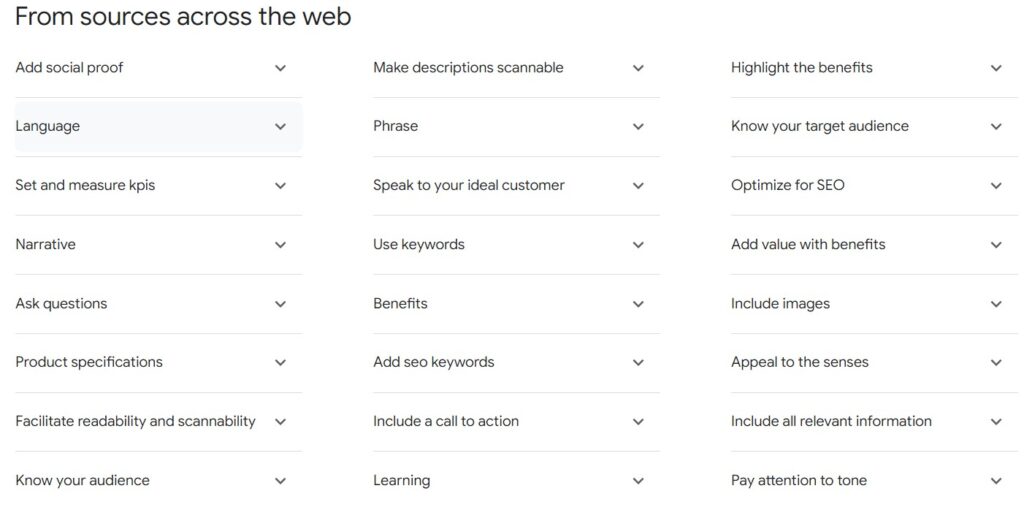Establishing a company is one thing; turning a profit is quite another. You also compete in a completely different field if your goal is to create a powerful, competitive, and long-lasting eCommerce brand.
Ecommerce growth strategy has become essential for any company looking to expand its customer base and boost earnings in this digital age. But with the intense competition in the internet space, it takes more than just having an eCommerce website for sale to be necessary. In order to enhance eCommerce sales and optimize your website for search engines, you must do so.
1. Making Product Descriptions More Effective
In order to inform and convince potential buyers to buy a product, product descriptions are crucial. If you want your product descriptions to make a big splash, use these strategies:
Differentiate your products from the competition and boost e-commerce sales by highlighting their unique features. Make use of bold or bullet points to highlight your product’s most appealing features. Take handmade jewelry as an example. It’s important to emphasize that each piece is one-of-a-kind and crafted using top-notch materials. Highlight the one-of-a-kind details in the design or the sustainable manufacturing technique if you’re in the apparel business.

Customers can see exactly what they’re getting when they shop online, therefore high-quality photos are essential for boosting your ecommerce sales. Take pictures from various vantage points and crop in close-ups of key elements. When describing products, less is often more. Give prospective customers only the information they need without sugarcoating it. To make the writing easier to read, use brief paragraphs or bullet points. Details like size, color choices, materials, and maintenance instructions should be included.
2. Promote on Other Social Networks
Social media has great potential for product promotion and sales. Your ecommerce sales can rise by understanding social media channels and implementing distinct promotional efforts for each. Your target audience may have diverse interests and be scattered across several social networks. Therefore, tailor your messaging to each medium to increase reach and engagement. Instagram’s visually appealing platform requires high-quality product photographs or videos, while LinkedIn’s professional, informational approach may work well.
You can establish targeted promotional campaigns on Facebook with a broad or narrow reach. Facebook’s ad platform lets you target audiences by likes, region, age, etc. Twitter promotions can be created with catchy language and appropriate hashtags. This site is ideal for influencer marketing if applicable to your brand. Instagram suits firms with attractive items. Instagram promotional campaigns might include high-quality photographs and videos, Instagram stories, shoppable posts, and influencer collaborations. LinkedIn suits B2B companies. Sharing informative blog entries, seminars, or whitepapers about your products can attract customers.
Cross Promotion Ideas
Influencer posts
Promotional videos
Giveaways and contests
Guests on podcasts
Email marketing
Webinars
Well-structured social media promotions can attract your broad audience and turn them into active purchasers. Understanding your audience and platform’s intricacies is the first step. With that insight, you can build site-specific marketing that boost ecommerce sales, brand recognition, and consumer loyalty.
3. Enhanced User Experience
User experience is crucial for increasing sales in online stores. If you want more people to convert into buyers, your website needs to be easy to use, fast to load, and mobile-friendly. Also, if you provide live chat assistance, customers can ask questions and get answers before, during, and after the purchase process. Streamlining navigation is the most critical part of improving user experience. This includes making sure your website’s menu is easy to understand and uses simple language so that users can get what they need. To facilitate browsing, you may want to think about arranging your products into several categories and subcategories.
Optimize website navigation: Make sure your website is straightforward to navigate by employing a clear, well-organized menu structure and a user-friendly layout.
Speed up page load times: Users anticipate rapid responses, so it’s crucial to optimize image sizes, utilize browser caching, and streamline your code to boost page loading times. Tools like New Relic browser monitoring can pinpoint performance issues, allowing for timely optimizations.
Ensure mobile responsiveness: As mobile usage grows, ensuring your website is responsive to mobile devices is critical for maintaining a positive user experience.
Personalize user interactions: Leverage data analytics to provide personalized content and recommendations, which can increase user engagement and satisfaction.
Focus on user-centred design: Focus on designing your digital platforms with the end-user in mind, ensuring they are easy to use and accessible.
In this digital age, no one has time to wait around for a website to load slowly. Improving your site’s performance can have a positive impact on both user experience and search engine rankings. You can speed up load times by reducing code and picture compression.
Make sure your website is mobile-friendly because more and more consumers are buying online from their phones. Making sure buttons are large enough to tap easily and utilizing responsive design to adjust your site’s layout depending on screen size are both part of mobile SEO.
4. Creating an Email List
Building an email list boosts online sales. Email is still a powerful tool for building client relationships and increasing sales. A list of email addresses belongs to potential customers who have shown interest in your brand or items. These people are more inclined to buy. Get in touch with these people via email to promote your products or provide exclusive promotions.
Adding a newsletter signup form to your website is an easy approach to expand your email list. Offer a discount code, free shipping, or industry news to attract subscribers. Pop-ups are also an effective email address collector. Subscribers may receive a discount or early access to new products. Capturing consumer emails during checkout is another successful way. Be upfront about how you’ll use their email addresses to comply with privacy rules.
Once you have a list, personalize your emails as much as possible. Name the recipient, wish them a happy birthday, or suggest things based on their browsing behavior. Create urgency to motivate speedy action. Avoiding commercial emails is usually considered a good ecommerce growth strategy. Then sharing product-related material benefits your subscribers. You should give customers early access to new products to keep them interested. Building your email list steadily could be one of your most profitable ways for how to increase ecommerce sales with the appropriate methods.
5. Add Website Reviews
Shopping habits are heavily influenced by online reviews. They offer third-party product insights and develop customer trust, which is vital in ecommerce services. Customer reviews can greatly affect a product’s sales, according to research. Even with five reviews, products with high ratings can convert better. However, no reviews or bad ratings may discourage customers. Customer reviews also provide extra product information. This can boost “Buy” clicks.

It’s crucial to simplify customer review submission. You need to follow up emails thanking customers and invite them to review products after sales. You need to offer discount vouchers, loyalty points, or giveaways to encourage reviews. A clear call to action, a basic form, and an easy-to-understand rating system are included.
Though undesirable, negative evaluations are inevitable. They can be harmless if managed properly. Your firm can learn and improve from unfavorable reviews that point out product flaws or service mistakes. Reviews on your ecommerce website build trust and boost sales. Remember honesty is crucial. Don’t alter reviews. Genuine customer reviews—good or bad—help maintain your online store’s legitimacy.
CONCLUSION
Starting an online store is just the beginning. Selling more and broadening its reach are the major challenges. Fortunately, there are many ways to overcome this hurdle, each has the potential for how to increase ecommerce sales. Remember, ecommerce growth strategy and success depends on personalizing techniques to your business model, target audience, product line, and brand philosophy.
Reading this blog might have shown you that increasing your online store’s revenue isn’t rocket science. Numerous tactics exist that are both simple to apply and quite successful. Also, test out a bunch of different approaches to see which ones work best for your sales.
But Robiz Solutions is here to help if you want to put your online shop on full autopilot so you can concentrate on other parts of your business. Starting with setup and continuing through day-to-day operations, Robiz Solutions can manage every aspect and help you with how to increase ecommerce sales. To know more about us and how we can help, book a free demo now.
FAQs
How can I use social media to get more people to buy things online?
Make and share content that is relevant to your audience’s wants and interests to keep them interested. Use targeted ads on sites like Instagram and Facebook to get in touch with possible customers more easily.
How can I get people to buy my goods?
Make sure that users have a good time on both desktop computers and cell phones. To reach your goal group, you might also want to improve your product descriptions and make them relevant.
What makes ecommerce more productive?
Ecommerce platforms let businesses analyze stock levels, keep an eye on product popularity, and improve supply chains by streamlining inventory management procedures. This effectiveness ensures a better balance between supply and demand by reducing the possibility of overstocking.






